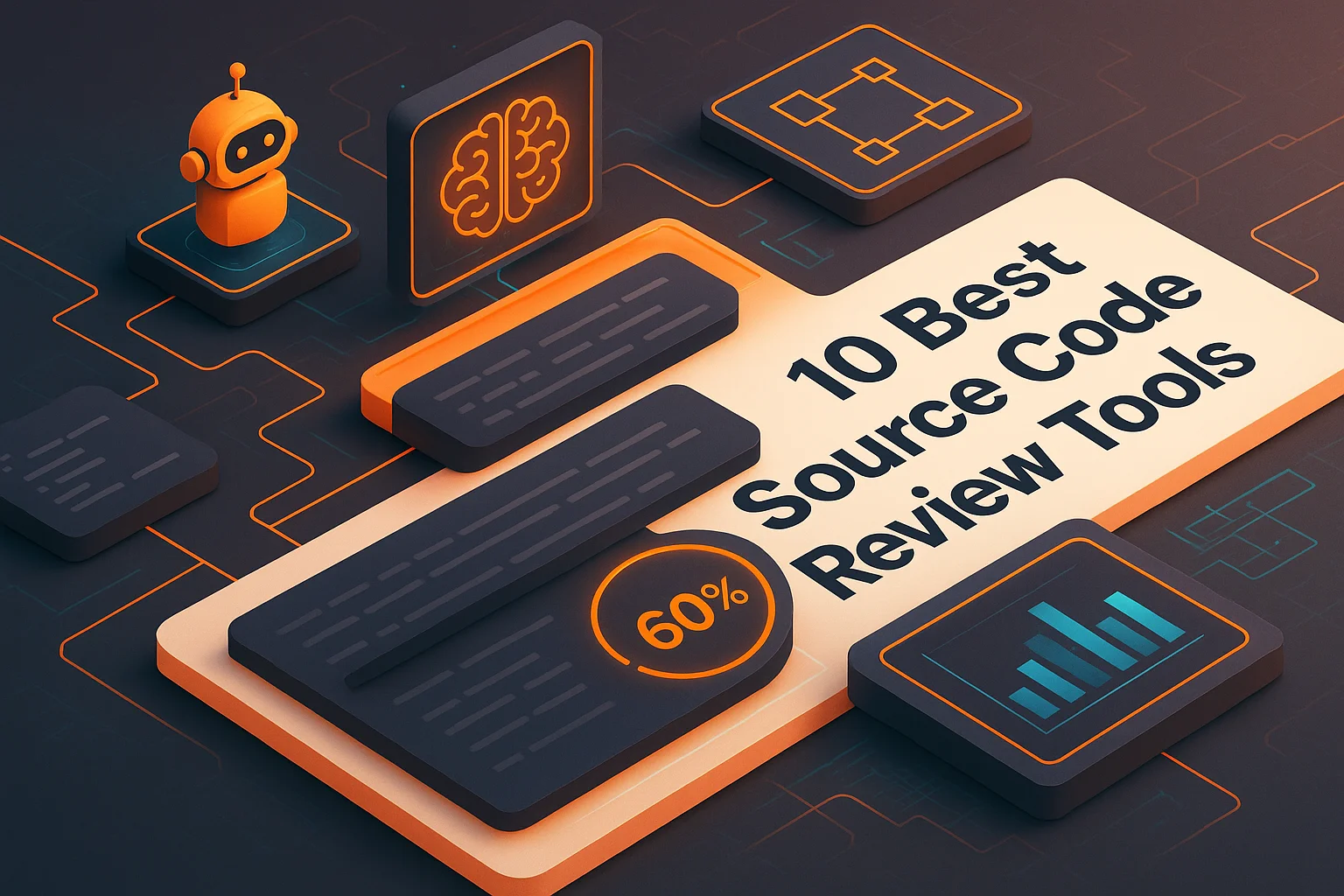Top AI Tools to Help With Code Quality for Software Teams

Code quality isn't just about writing clean code—it's about building software that's maintainable, secure, and scalable. With AI revolutionizing how we approach development, smart teams are leveraging AI-powered tools to catch bugs earlier, improve security, and accelerate their development cycles. This comprehensive guide explores the top AI tools that can transform your code quality processes, from automated code reviews to intelligent testing and security analysis. Whether you're a startup looking to scale efficiently or an enterprise seeking to enhance your development workflow, these AI tools can help your team ship better code faster.
Key Takeaways
- •AI tools complement human expertise: The most effective approach combines AI automation for routine tasks with human judgment for complex decisions, creating a balanced workflow that maximizes both efficiency and quality.
- •Early integration yields maximum benefits: Teams that integrate AI tools early in their development process catch issues sooner, reduce technical debt, and maintain higher code quality standards throughout the project lifecycle.
- •Choose tools that fit your workflow: Success depends on selecting AI tools that integrate seamlessly with your existing development environment, team processes, and technical stack rather than forcing workflow changes.
Why AI Tools Are Essential for Modern Code Quality
Traditional code quality practices—while foundational—struggle to keep pace with modern development demands. Manual code reviews, while valuable, can be time-consuming and may miss subtle issues. Static analysis tools help, but they often generate false positives and lack context. AI-powered tools bridge this gap by providing intelligent analysis that learns from patterns, adapts to your codebase, and delivers more accurate insights.
The benefits extend beyond just catching bugs. AI tools can identify security vulnerabilities, suggest performance optimizations, ensure coding standards compliance, and even predict potential maintenance issues. This proactive approach to code quality helps teams ship more reliable software while reducing the long-term costs of technical debt.
The Evolution of Code Quality Tools
We've evolved from simple linters to sophisticated AI systems that understand code context, business logic, and even team preferences. Modern AI tools can analyze code at multiple levels—from syntax and style to architecture and security—providing comprehensive insights that help teams make informed decisions about their codebase.
Top AI-Powered Code Review Tools
AI-powered code review tools are transforming how teams approach code quality. These tools analyze code changes, provide intelligent suggestions, and help maintain consistent standards across your development team.
Propel - AI-Powered Code Review Assistant
Propel represents the next generation of code review tools, combining advanced AI with deep understanding of software development best practices. Unlike traditional tools that focus on syntax checking, Propel analyzes your code in context, understanding your business logic, team patterns, and project requirements.
Key features include intelligent bug detection, security vulnerability identification, performance optimization suggestions, and automated compliance checking. Propel integrates seamlessly with popular version control systems and provides actionable feedback that helps developers improve their code quality in real-time.
DeepCode (now Snyk Code)
DeepCode uses machine learning to analyze millions of open-source projects, learning from collective coding patterns to identify potential issues in your code. The tool excels at finding complex bugs that traditional static analysis might miss, including logical errors and security vulnerabilities.
The platform supports multiple programming languages and provides detailed explanations for each finding, helping developers understand not just what's wrong, but why it's problematic and how to fix it.
CodeGuru by Amazon
Amazon CodeGuru combines automated code reviews with application performance recommendations. The tool analyzes your code for expensive operations, identifies resource leaks, and suggests optimizations based on AWS best practices.
AI-Powered Testing and Quality Assurance
Testing is where AI truly shines, automating not just test execution but test creation, maintenance, and optimization. These tools can generate comprehensive test suites, identify edge cases, and adapt to code changes automatically.
Testim
Testim uses AI to create, execute, and maintain automated tests. The platform's machine learning algorithms can identify UI elements even when they change, reducing test maintenance overhead. Testim also provides intelligent test case generation based on user behavior patterns.
Mabl
Mabl offers intelligent test automation that learns from your application's behavior. The tool can automatically detect visual changes, performance regressions, and functional issues. Its AI-powered insights help teams prioritize testing efforts and focus on the most critical areas.
Applitools
Applitools specializes in visual testing using AI to detect visual bugs and inconsistencies across different browsers and devices. The platform's Visual AI engine can identify subtle visual differences that human testers might miss, ensuring consistent user experiences.
Security-Focused AI Tools
Security vulnerabilities can be costly and damaging. AI-powered security tools analyze code for potential security flaws, from common vulnerabilities to sophisticated attack vectors.
Veracode
Veracode's AI-powered static analysis identifies security vulnerabilities throughout the development lifecycle. The platform provides detailed remediation guidance and integrates with popular development tools to provide security feedback without disrupting workflows.
Checkmarx
Checkmarx uses AI to enhance its static application security testing (SAST) capabilities. The tool can identify complex security patterns, reduce false positives, and provide accurate vulnerability assessments across multiple programming languages.
Snyk
Snyk combines dependency scanning with AI-powered vulnerability detection. The platform identifies security issues in open-source dependencies and provides automated fix suggestions, helping teams maintain secure codebases with minimal effort.
Performance and Optimization Tools
AI tools can identify performance bottlenecks, suggest optimizations, and help teams build more efficient applications. These tools analyze code patterns, resource usage, and runtime behavior to provide actionable insights.
Intel VTune Profiler
Intel VTune Profiler uses AI to analyze application performance and identify optimization opportunities. The tool provides detailed insights into CPU usage, memory access patterns, and threading efficiency.
New Relic
New Relic's AI-powered APM (Application Performance Monitoring) platform provides intelligent insights into application performance. The tool can predict performance issues, identify root causes, and suggest optimizations based on real-world usage patterns.
Dynatrace
Dynatrace uses AI to provide full-stack monitoring and automated problem detection. The platform's Davis AI engine can identify performance issues, trace root causes, and provide remediation suggestions across complex distributed systems.
Code Documentation and Analysis
Good documentation is crucial for code quality, but it's often neglected. AI tools can automatically generate documentation, analyze code complexity, and provide insights into code maintainability.
Mintlify
Mintlify uses AI to automatically generate documentation from code comments and function signatures. The tool can create comprehensive API documentation, code explanations, and usage examples.
Sourcegraph
Sourcegraph provides AI-powered code search and analysis capabilities. The platform can understand code semantics, identify code patterns, and provide insights into code usage across large codebases.
CodeClimate
CodeClimate uses AI to analyze code quality metrics, identify technical debt, and provide maintainability insights. The tool can track code quality trends over time and help teams make data-driven decisions about refactoring efforts.
Choosing the Right AI Tools for Your Team
Selecting the right AI tools depends on your team's specific needs, existing workflow, and technical requirements. Consider these factors when evaluating AI-powered code quality tools:
Integration and Workflow Compatibility
The best AI tools integrate seamlessly with your existing development environment. Look for tools that support your version control system, CI/CD pipeline, and development frameworks. Consider how the tool will fit into your team's current workflow without requiring significant changes.
Language and Framework Support
Ensure the AI tools you choose support your programming languages and frameworks. Some tools excel in specific languages, while others provide broad coverage. Consider your technology stack and future plans when making your selection.
Team Size and Scalability
Different tools work better for different team sizes. Some AI tools are designed for small teams with simple pricing models, while others are built for enterprise-scale deployments with advanced features and compliance requirements.
Cost and ROI Considerations
While AI tools can provide significant value, it's important to consider the cost-benefit ratio. Factor in licensing costs, implementation time, and training requirements. Look for tools that provide clear metrics and demonstrate measurable improvements in code quality and development velocity.
Implementation Best Practices
Successfully implementing AI tools requires more than just installation. Here are key practices for maximizing the value of AI-powered code quality tools:
Start with a Pilot Project
Begin with a small, manageable project to test the AI tools and understand their impact. This approach allows you to identify potential issues, refine your process, and demonstrate value before rolling out to the entire team.
Establish Clear Guidelines
Define clear guidelines for how AI tools should be used in your development process. Specify when manual review is required, how to handle AI suggestions, and what standards need to be maintained. This clarity helps team members understand expectations and use the tools effectively.
Provide Training and Support
Ensure your team understands how to use the AI tools effectively. Provide training on the tools' capabilities, limitations, and best practices. Consider designating AI tool champions who can help other team members and stay updated on new features.
Monitor and Measure Impact
Track key metrics to measure the impact of AI tools on your code quality and development process. Monitor bug reduction rates, review time improvements, and developer satisfaction. Use this data to refine your approach and demonstrate the value of your investment.
The Future of AI in Code Quality
AI in code quality is rapidly evolving, with new capabilities emerging regularly. Understanding future trends can help you make informed decisions about tool selection and process improvements.
Predictive Code Quality
Future AI tools will be able to predict code quality issues before they occur. By analyzing development patterns, team behavior, and historical data, these tools will provide proactive recommendations to prevent quality problems.
Natural Language Code Review
AI tools are becoming better at explaining code issues in natural language, making them accessible to developers of all skill levels. This trend will help democratize code quality practices and improve team collaboration.
Autonomous Code Improvement
Advanced AI systems will be able to automatically fix certain types of code issues, from simple style violations to complex refactoring tasks. This automation will free developers to focus on higher-level problem-solving and creative work.
Frequently Asked Questions
How do AI tools compare to traditional code quality tools?
AI tools offer several advantages over traditional static analysis tools. They can understand code context, learn from patterns, and provide more accurate results with fewer false positives. However, they work best when combined with traditional tools and human expertise, not as complete replacements.
What's the typical ROI for implementing AI code quality tools?
Teams typically see 20-40% reduction in bug discovery time and 30-50% improvement in code review efficiency. The exact ROI depends on team size, codebase complexity, and current quality practices. Most teams see positive returns within 3-6 months of implementation.
Can AI tools replace human code reviewers?
AI tools are powerful assistants, not replacements for human reviewers. They excel at identifying patterns, catching common issues, and providing consistent analysis. However, human reviewers are still essential for understanding business logic, making architectural decisions, and providing mentorship to junior developers.
How do I get my team to adopt AI code quality tools?
Start with a pilot project, provide clear training, and demonstrate value through metrics. Address concerns about job displacement by emphasizing how AI tools augment human capabilities rather than replace them. Choose tools that integrate well with existing workflows to minimize disruption.
What are the privacy and security considerations for AI code quality tools?
Consider where your code will be processed (cloud vs. on-premise), data retention policies, and compliance requirements. Look for tools that offer security certifications, encryption, and clear privacy policies. Some tools offer on-premise deployment options for sensitive codebases.
Related internal reading
Ready to Transform Your Code Review Process?
See how Propel's AI-powered code review helps engineering teams ship better code faster with intelligent analysis and actionable feedback.

